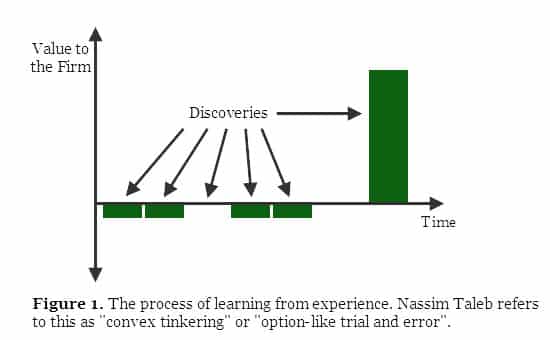A natural and unstructured process that results from doing the work
LAST week we looked at the value of breaking with experience, which followed on nicely from our initial article on the Experience Curve.
This week we focus on learning from experience. What does it mean to learn from experience? And what role does management have to play, if any?
In his book Competitive Advantage, Michael Porter states that “learning does not occur automatically but results from the effort and attention of management and employees … Management must demand learning improvements and establish targets for them, rather than simply hope that learning will occur.”
What is Porter talking about? Is he suggesting that a firm should be run like a university where management lays down a clear curriculum and set of learning outcomes?
Yes, it certainly seems that way. Porter appears to be suggesting that learning is a top down process which management can decree with a snap of its fingers and a pithy incantation, “let there be learning”.
He appears to have things backwards.
If you think of a school curriculum as a pre-planned course of directed study taught as an end in itself rather than developed in response to the pressure of market forces, then learning from experience is exactly the opposite.
People and organisations learn naturally, and often serendipitously, as they gain production experience. This process of natural learning is what Nassim Taleb calls convex tinkering, the option-like trial and error process where people make lots of low cost “mistakes” (that is, discoveries which don’t lead to improved performance) and a handful of breakthroughs.
In other words, learning is a natural and unstructured process that occurs as a matter of course when people show up and make an effort. As people gain experience they observe what works and what doesn’t work, and are thereby able to learn and improve.
People learn from experience. This is a pretty intuitive idea, but it leads to a strange result.
In our article on the Experience Curve we highlighted research showing that, for any given firm, the performance improvements resulting from production experience tend to occur at a predictable rate. That is, a firm’s rate of learning appears to remain fairly constant over time.
This is surprising.
If learning is a natural, unstructured, and somewhat serendipitous process then the last thing we would expect is for the rate of learning to be predictable.
What could be driving this phenomenon?
A possible explanation is that, while the chance of learning something valuable on any given occasion is uncertain, the rate of learning for a group of people over a period of time converges to a stable average (assuming of course that the business landscape and management policies remain unchanged). In other words, any randomness in the learning process may just cancel itself out.
If you are a statistics buff, then you will know that this sort of thing happens all the time when dealing with large amounts of data. So much so that it is has been given a name, the law of large numbers, a property by which the average result from a large number of observations of a random event should be pretty close to what you would expect. For example, if a large number of six sided dice are rolled then the average roll should be quite close to (1+2+3+4+5+6)/6 = 3.5 .
This is all very well, but why should we expect a firm’s rate of learning to be stable over time or, for that matter, to follow any predictable pattern?
We were at a total loss to answer this question, until yesterday that is, when we made a happy and unexpected discovery by complete accident: a Youtube video about slime mould.
In the Youtube clip, Heather Barnett shares a fascinating story about how Physarum Polycephalum, otherwise known as “slime mould”, has demonstrated an ability to discover food, map territory, navigate a maze by the shortest route, and anticipate temperature changes.
Slime mould is a collection of single celled organisms with no brain, no nervous system, and no language. But despite these limitation, it has shown an ability to learn, remember and solve problems.
From single celled organisms on one end of the spectrum to large multinational corporations on the other, an ability to learn from experience appears to be an innate property of life itself. This is a tantalising and slightly torturous discovery since it means that the constant rate of learning revealed by the Experience Curve effect may defy a deeper explanation. It may be a shadow cast by something unseen and unknowable.
When Porter stated that “learning does not occur automatically but results from the effort and attention of management and employees” he was almost right. What he should have said, and what he perhaps meant to say, is that “learning does occur automatically and might be enhanced by the effort and attention of management and employees”.
Which brings us to the second question, how can learning be enhanced by the efforts of management?
A very good question, and one that deserves careful attention.
If you are interested to come with us as we continue to explore the field of organisational learning, please read next week’s article which will look at the 5 ways management can foster learning within a firm.
Image: Flickr

